
Edible mushrooms are the fleshy fruit bodies of several species of macrofungi. Edibility may be defined by criteria including the absence of poisonous effects on humans and desirable taste and aroma. Mushrooms that have a particularly desirable taste are described as "choice". Edible mushrooms are consumed for their nutritional and culinary value. Mushrooms, especially dried shiitake, are sources of umami flavor.

Amanita pantherina, also known as the panther cap, false blusher, and the panther amanita due to its similarity to the true blusher, is a species of fungus found in Eurasia with poisonous and psychoactive properties.

Flammulina filiformis is a species of edible agaric in the family Physalacriaceae. It is widely cultivated in East Asia, and well known for its role in Japanese and Chinese cuisine. Until recently, the species was considered to be conspecific with the European Flammulina velutipes, but DNA sequencing has shown that the two are distinct.

An annulus is the ring-like or collar-like structure sometimes found on the stipe of some species of mushrooms. The annulus represents the remnants of the partial veil, after it has ruptured to expose the gills or other spore-producing surface. It can also be called a ring which is what the Latin word annulus directly translates as. The modern usage of the Latin word originates from the early days of botany and mycology when species descriptions were only written in Latin. Outside of the formal setting of scientific publications which still have a Latin requirement, it will often just be referred to as a ring or stem ring in field guides and on identification websites.
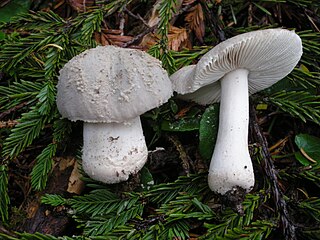
Amanita farinosa, commonly known as the eastern American floury amanita or the American floury amanita, is a North American poisonous mushroom of the genus Amanita, a genus of fungi including some of the most deadly mushrooms.
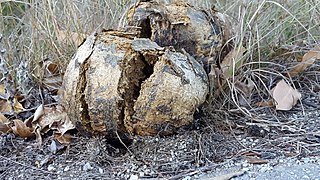
Pisolithus arhizus, commonly known as the dead man's foot, dyeball, pardebal, or Bohemian truffle, is a widespread earth-ball like fungus, which may in fact be several closely related species. This puffball's black viscous gel is used as a natural dye for clothes. Pisolithus arhizus is a major component in mycorrhizal fungus mixtures that are used in gardening as powerful root stimulators. It is inedible.
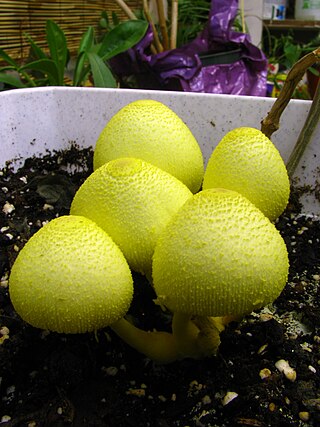
Leucocoprinus is a genus of fungi in the family Agaricaceae. Its best-known member is the distinctive yellow mushroom Leucocoprinus birnbaumii, which is found in plant pots and greenhouses worldwide. The type species is Leucocoprinus cepistipes. The genus has a widespread distribution and contains over 80 recognised species, however many of these species are very scarcely recorded and little known with only a small number of Leucocoprinus species which are commonly observed. The majority of the species in this genus are exclusive to tropical environments however numerous species have become a common sight in plant pots and greenhouses resulting in them becoming well known worldwide.
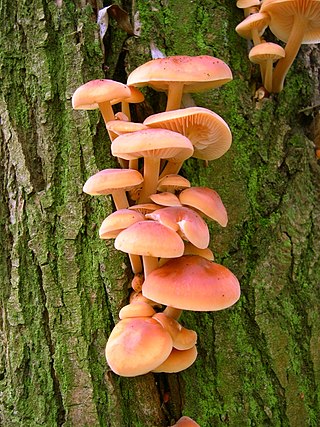
Flammulina velutipes, commonly known as the velvet foot, wild enoki, velvet stem, or velvet shank, is a species of gilled mushroom in the family Physalacriaceae. The species occurs in Europe and North America. Until recently Flammulina velutipes was considered to be conspecific with the Asian Flammulina filiformis, cultivated for food as "enokitake" or "golden needle mushroom", but DNA sequencing has shown that the two are distinct.

Baccatin III is an isolate from the yew tree. Baccatin III is a precursor to the anti-cancer drug paclitaxel (Taxol).
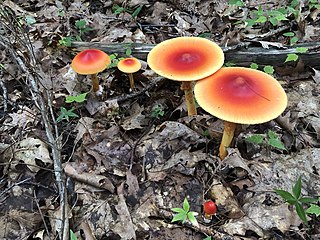
Amanita jacksonii, also known as Jackson's slender amanita, American Slender Caesar, and Eastern Caesar's Amanita, is a North American species of fungus in the family Amanitaceae. It is a reddish-orange colored mushroom species which can be identified by its yellow gills, large, white, sacklike volva.
Galactan endo-beta-1,3-galactanase is an enzyme with systematic name arabinogalactan 3-beta-D-galactanohydrolase. This enzyme catalyses the following chemical reaction

Callistosporium purpureomarginatum is a species of agaric fungus in the family Tricholomataceae. Found in the United States, it was officially described in 1996.
Medicinal fungi are fungi that contain metabolites or can be induced to produce metabolites through biotechnology to develop prescription drugs. Compounds successfully developed into drugs or under research include antibiotics, anti-cancer drugs, cholesterol and ergosterol synthesis inhibitors, psychotropic drugs, immunosuppressants and fungicides.
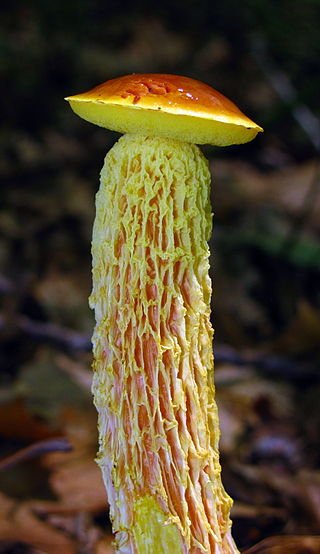
Aureoboletus betula is a species of mushroom producing fungus in the family Boletaceae. It is commonly known as the Shaggy Stalked Bolete.

Flammulina fennae is an edible winter mushroom. It is very similar to closely related species Flammulina velutipes, but differs by having a paler cap.

Phellinus robiniae, commonly called the cracked cap polypore or Phellinus rimosus, is a fungus of the family of Hymenochaetaceae. The fungus primarily infests black locusts, aided by openings caused by Megacyllene robiniae infestation, but also grows on various other trees such as Carya, oak, and Acacia. Cracked cap polypore is sympatric with most of its hosts. It has a brown spore print, leaving brown streaks on the tree below the fungus.
Leucocoprinus straminellus is a species of mushroom producing fungus in the family Agaricaceae. Like other Leucocoprinus species it may have originated in a tropical climate but now finds a home in plant pots, greenhouses and compost piles in many countries. Leucocoprinus straminellus is described as being similar to the more commonly known Leucocoprinus birnbaumii but it is smaller and a lighter shade of yellow with smaller spores that lack a germ pore. It is also described as being superficially similar to Leucocoprinus fragilissimus but slightly more robust with flesh that is less translucent.
Leucocoprinus flavescens is a species of mushroom-producing fungus in the family Agaricaceae.
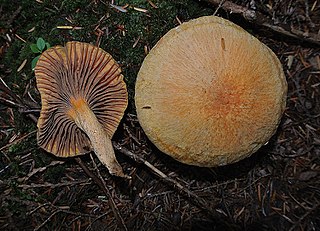
Chroogomphus ochraceus is a species of fungus from the family Gomphidiaceae. Known for its close association with conifer trees–especially pines, it is often referred to as the “pine spike” or “spike cap” fungus. C. ochraceus was originally identified as a species limited to the Pacific Northwest because of its display of distinct yellowish colors, but recent research has concluded that this species is widespread across North America and that it is genetically distinct from Chroogomphus rutilus, which is limited to Europe.

Cantharellus confluens is a species of Cantharellus found in North America.
















